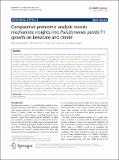| dc.contributor.author | Mandalakis, Manolis | en_US |
| dc.contributor.author | Panikov, Nicolai | en_US |
| dc.contributor.author | Dai, Shujia | en_US |
| dc.contributor.author | Ray, Somak | en_US |
| dc.contributor.author | Karger, Barry L | en_US |
| dc.date.accessioned | 2014-03-11T02:48:16Z | |
| dc.date.issued | 2013 | en_US |
| dc.identifier.citation | Mandalakis, Manolis, Nicolai Panikov, Shujia Dai, Somak Ray, and Barry L Karger. 2013. “Comparative proteomic analysis reveals mechanistic insights into Pseudomonas putida F1 growth on benzoate and citrate.” AMB Express 3 (1): 64. doi:10.1186/2191-0855-3-64. http://dx.doi.org/10.1186/2191-0855-3-64. | en |
| dc.identifier.issn | 2191-0855 | en |
| dc.identifier.uri | http://nrs.harvard.edu/urn-3:HUL.InstRepos:11879023 | |
| dc.description.abstract | Pseudomonas species are capable to proliferate under diverse environmental conditions and thus have a significant bioremediation potential. To enhance our understanding of their metabolic versatility, this study explores the changes in the proteome and physiology of Pseudomonas putida F1 resulting from its growth on benzoate, a moderate toxic compound that can be catabolized, and citrate, a carbon source that is assimilated through central metabolic pathways. A series of repetitive batch cultivations were performed to ensure a complete adaptation of the bacteria to each of these contrasting carbon sources. After several growth cycles, cell growth stabilized at the maximum level and exhibited a reproducible growth profile. The specific growth rates measured for benzoate (1.01 ± 0.11 h-1) and citrate (1.11 ± 0.12 h-1) were similar, while a higher yield was observed for benzoate (0.6 and 0.3 g cell mass per g of benzoate and citrate, respectively), reflecting the different degrees of carbon reduction in the two substrates. Comparative proteomic analysis revealed an enrichment of several oxygenases/dehydrogenases in benzoate-grown cells, indicative of the higher carbon reduction of benzoate. Moreover, the upregulation of all 14 proteins implicated in benzoate degradation via the catechol ortho-cleavage pathway was observed, while several stress-response proteins were increased to aid cells to cope with benzoate toxicity. Unexpectedly, citrate posed more challenges than benzoate in the maintenance of pH homeostasis, as indicated by the enhancement of the Na+/H+ antiporter and carbonic anhydrase. The study provides important mechanistic insights into Pseudomonas adaptation to varying carbon sources that are of great relevance to bioremediation efforts. | en |
| dc.language.iso | en_US | en |
| dc.publisher | Springer | en |
| dc.relation.isversionof | doi:10.1186/2191-0855-3-64 | en |
| dc.relation.hasversion | http://www.ncbi.nlm.nih.gov/pmc/articles/PMC3827995/pdf/ | en |
| dash.license | LAA | en_US |
| dc.subject | | en |
| dc.subject | Benzoate biodegradation | en |
| dc.subject | Batch culture | en |
| dc.subject | Quantitative proteomics | en |
| dc.subject | 2D-LC-MS/MS | en |
| dc.subject | Stress response | en |
| dc.title | Comparative proteomic analysis reveals mechanistic insights into Pseudomonas putida F1 growth on benzoate and citrate | en |
| dc.type | Journal Article | en_US |
| dc.description.version | Version of Record | en |
| dc.relation.journal | AMB Express | en |
| dash.depositing.author | Panikov, Nicolai | en_US |
| dc.date.available | 2014-03-11T02:48:16Z | |
| dc.identifier.doi | 10.1186/2191-0855-3-64 | * |
| dash.contributor.affiliated | Panikov, Nicolai | |


